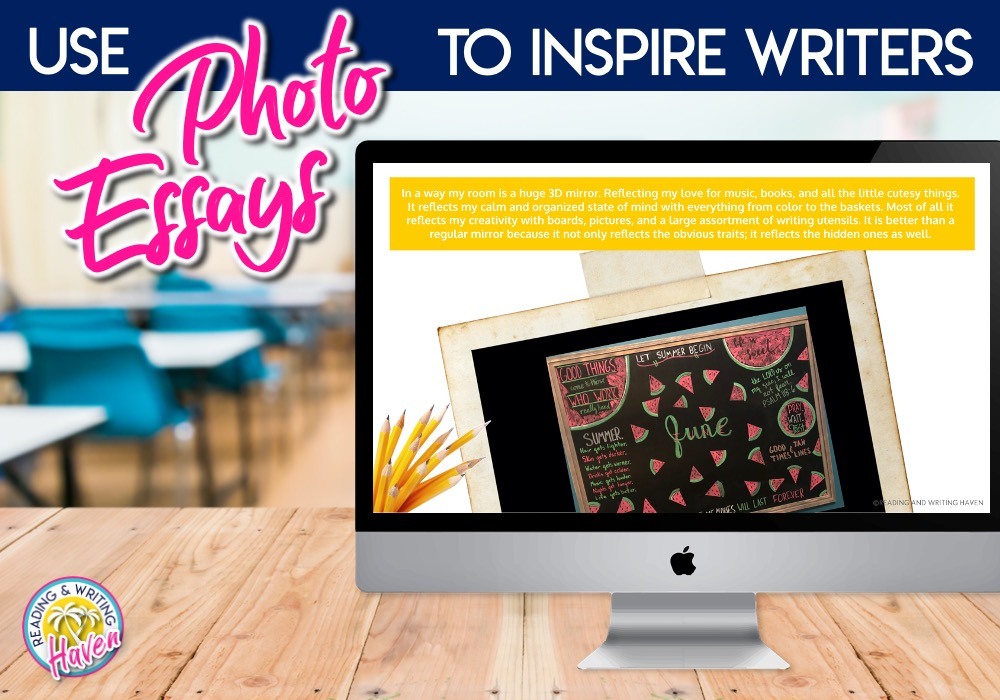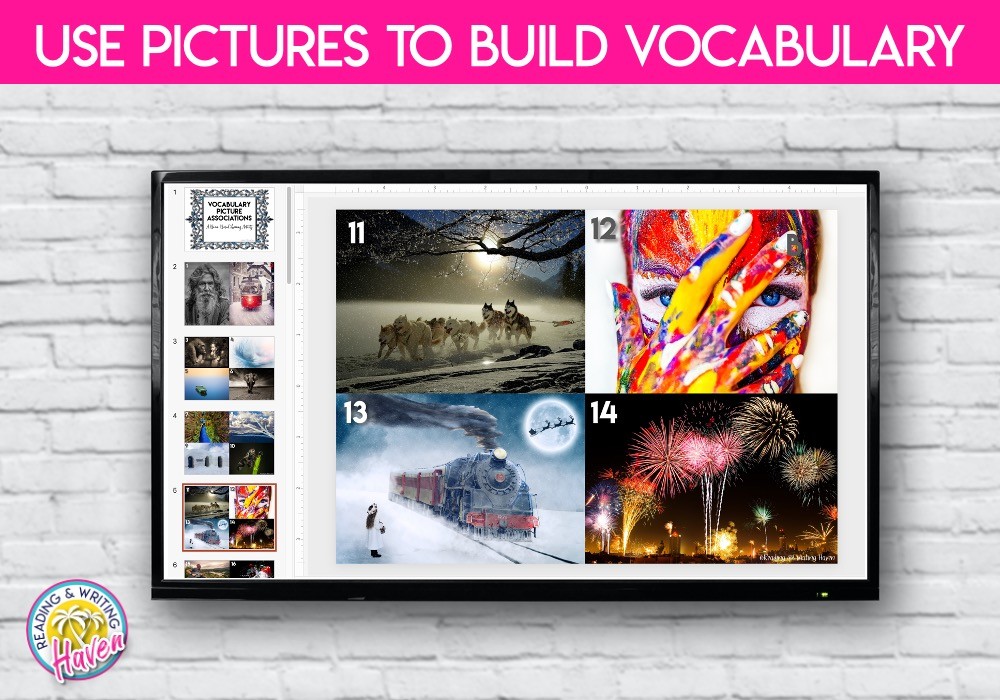Teaching with Photographs: 3 Powerful Ways to Boost Literacy
Inside: Teaching with photographs is powerful. With just a single image, educators can convey complex ideas, helping students make deep connections. In an age of digital literacy, students need to be able to analyze photographs, write using multimedia, and make visual connections.
It all started the day I decided to put a photo on the board to introduce literary analysis. Perhaps today, it’s not that “new” of an approach. But to my new teacher self fifteen years ago, it was something. My lesson planning had bored me, and I needed a way to make introducing the skill of analysis more engaging — for both myself and students!
To be honest, I wasn’t even really sure what type of image I was looking for…what kind would get me to the learning target I was trying to meet. So, I just picked one. I think it was a centaur on a beach, and he was advertising men’s deodorant. Yeah…a little odd.
While I wasn’t 100 percent confident in the image I chose, I figured, pictures have a way of captivating us, and each person makes such individualized connections. Surely we would come up with something!
Photographs are Opportunities for Critical Thinking
Have you ever noticed how students either gravitate to photos or completely ignore them? I’ve worked with students who refuse to read a book if it doesn’t have pictures. But, I’ve also watched students speed read through an informational text just to finish it, completely ignoring the graphics that are paired with the article to enhance understanding.
Since our digital world is becoming more visual by the day, we need to dig into media like photographs to enhance relevance. We need students to do more than notice images. They need to study them…investigate them…consider their purpose. Photographs are unique opportunities for critical thinking.
There is no shortage of ways to begin teaching with photographs. Here, I’m outlining three engaging options.
1. Media Literacy
Pictures are smattered all over the media. Students need to be aware that someone created these images for a purpose. Often, that purpose is to evoke emotion or action. While media images vary from political cartoons to news photographs to infographics and beyond, when we first introduce students to media literacy, it helps to start with a lesson on photographs in general.
We can ask students to consider the motive behind photographs. Who is the creator? What benefit does the photograph provide to them? Are we as viewers supposed to feel a certain emotion or take action? Being aware of point of view is a beneficial discussion as well. What biases does the photographer have that might impact the cropping, angle, or effects in this photo? And, what stereotypes or generalizations might we as readers bring to the photo that impact our analysis?
To take it a step further and add even more relevance to today’s world, we can ask students to talk about how photographers play a role in activism with social issues. They can find examples of how photo artists have contributed to movements, and they can even practice applying their own photography skills to issues they care deeply about.
During first semester with freshmen, I teach a large literary analysis unit that covers a variety of fiction and nonfiction text types, including both still and moving pictures. With this unit, I can cover a plethora of standards while connecting them all with the overarching theme of analyzing and citing text evidence.
2. Photo Essays
Essays will always be a valuable learning vehicle. Students need to be able to write an communicate clearly. Yet, I sense the structure and format for essays is evolving. While sometimes a straight-forward essay is what’s needed, other occasions call for something more creative.
Students have unique opportunities to enhance what they are saying with images. Why not intentionally incorporate photographs into essays to add a layer of personalization and meaning?
Teaching with photographs pairs well with informative essays, for example. They can be a little mundane to write. What if, instead of just researching and informing an audience about healthy eating habits, a student were to add photographs of healthy meals and snacks they made during their research project? What if students decide to participate in local activism movements? They could inform their audience about the events while also documenting them with images.
Photos can be used in narrative writing as well. Students can create descriptions for character portraits, write engaging plot twists to accompany photos they stage, and even write dialogue to accompany a photographed tableau.
3. Vocabulary Associations
Pictures have long been one of my very favorite vocabulary activities. When I first wanted to move beyond the vocabulary workbook that was full of boring, rote exercises that didn’t lead to deep learning, I began exploring pictures. You will understand the value of this enrichment activity if you try it yourself first.
Think of a word that you have recently learned. Perhaps it’s one you’ve just begun exploring with students or one you had to recently look up as you were doing some of your own reading. Then, find an image. Literally, Google some images. See how many connections you can make with those photographs using your word. What is it about the vocabulary word and the image that resonates with you?
This type of association internalizes words. When we make a visual, personal connection, or when we are able to tie a new word to our existing schema, we learn it, rather than memorizing it. And, that’s the power of pictures with vocabulary. Building vocabulary is a sure-fire way to enhance literacy skills.
Jennifer B.’s feedback on this vocabulary resource is one of my favorites:
This is the most amazing activity! I was skeptical, until I actually went through the pictures myself, thinking of random vocabulary words we have studied, and BAM! It totally worked!! No matter the word, I was able to connect it with one of the pictures. I tell my students that they don’t earn points by choosing a particular picture; they earn their points with their explanation of how the picture connects to the meaning. It is a real challenge! Love it!
Emphasizing Ethical Research
I would be remiss to write about teaching with photographs if I didn’t mention some of the many places we can find them! To enhance literacy skills with photographs, we can find images from a variety sources. These are a few of my favorites:
- public domain images
- self-taken photographs
- photographs from media – news articles, magazines, etcetera
Of course, when using photographs, it’s important that we capitalize on digital citizenship lessons. Specifically, students need to learn how to cite a variety of image types from the web. This process involves investigating the copyright information, license type, and usage details for each photo. (Yes, it can be time consuming, and we may have to teach students to abandon a photo if not enough information is available.)
When I was in school, I remember many of my teachers telling me I didn’t have to cite photographs. As a student, I was relieved. One less thing to do!
But then, as a teacher, I began telling my own students the same thing. Now, we live in a world where people are often using one another’s photographs without accrediting the source, which is not a good place to be. Teaching with photographs in a digital age requires a level of responsibility. We must teach students to give credit…but also to make sure the images can be used in the first place.
Making Learning Relevant
Now, to circle back to the centaur that smelled like Old Spice.
As I projected the image on the board, I asked students to make observations and inferences. I wanted them to tell me what was happening as well as how they knew. The result? Interesting conversations that made literary analysis tangible and accessible. As we moved forward from this unit hook, we were able to build on a common understanding (a picture in our minds) of what it means to break a text down into observable chunks to analyze.
Pictures are an excellent way to open doors for discussion, complex thinking, empathy, and passion. Because students are used to bite-sized learning via remote and blended situations, they pair well with the twenty-first century learning experience. What’s more relevant than using a medium students see in their EVERY DAY lives but often don’t know how to digest? We have the opportunity to help them interpret photos, determine purpose and credibility, and use pictures with multimedia to communicate clearly.
So, how are you teaching with photographs to boost literacy?
READ NEXT:
- 10 Fun Activities for Teaching Literary Analysis
- 13 Photo Inspired Poetry Teaching Ideas
- Getting Started with Visual Notetaking in the Classroom
- 11 Meaningful Ways to Use the Arts in ELA





One Comment
Comments are closed.